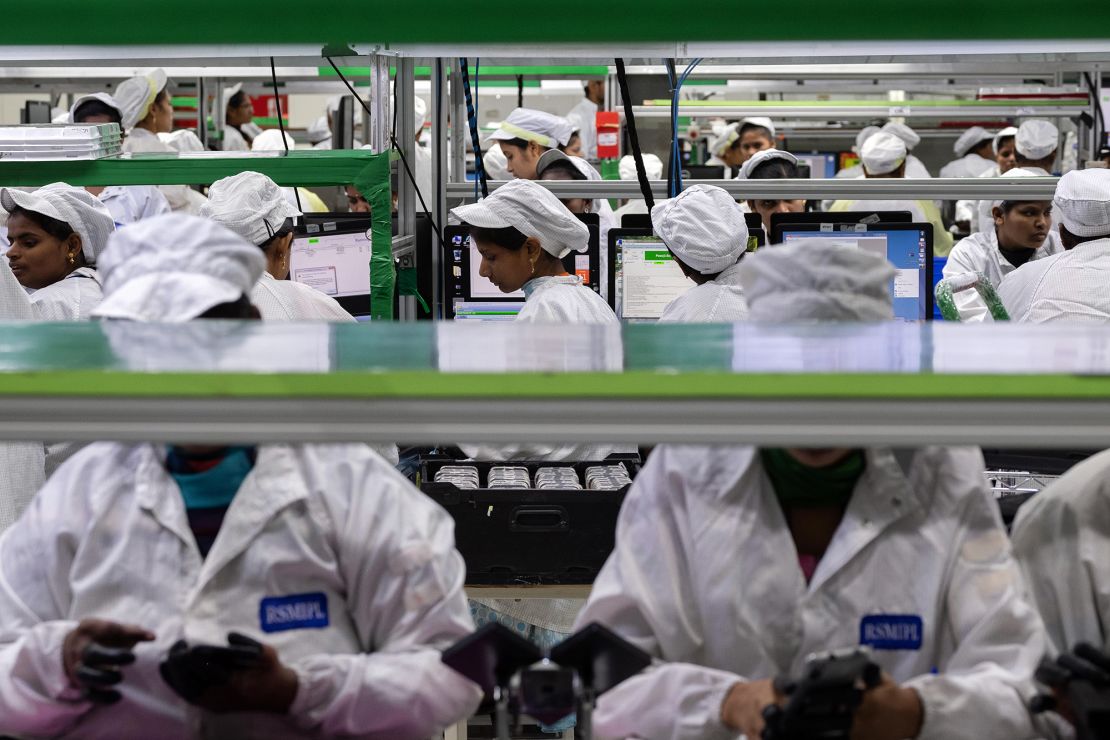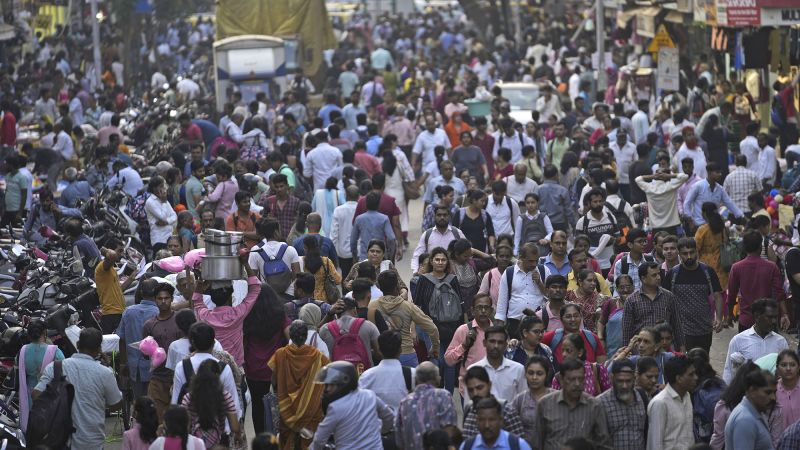India, the world’s fastest growing major economy, is not firing on all cylinders.
That’s a problem for Narendra Modi, who has just won a third consecutive five-year term as prime minister, although without a simple majority.
The 73-year-old wants to make the country a $5 trillion economy before the end of the current decade. His plans for reform have been complicated by the narrower-than-expected election victory, and there are major challenges ahead.
One entrenched problem standing in the way of India’s superpower ambitions is the lack of jobs for hundreds of millions of citizens, particularly women.
There are over 460 million women of working age in India — more than the entire population of the European Union — and they are more educated, aspirational and healthier than any previous generation.
But their dreams are clashing against a harsh reality.
Take Gunasri Tamilselvan, 22, who fears having to quit the job that she loves.
The engineering graduate started working at Finnish electronics manufacturer Salcomp’s factory in the southern Indian state of Tamil Nadu last year. Tamilselvan is part of a sought-after team making mobile chargers for major smartphone brands, but she has had to fight both at home and at work for her right to be financially independent.
And now, she is running out of time. Her family wants to arrange a marriage for her as soon as possible. In South Asia, it is still a norm for parents find spouses for their children.
“My father has not been very comfortable with my work,” she told CNN. “He has given me 10 months, after which he will choose a husband for me and get me married.”
If that happens, she would then have to negotiate with her husband and in-laws to continue working. It’s not the only battle she wants to win.
At the factory, she says she often works much harder to prove to her male colleagues that she deserves her place in the automation department, which involves dealing with the latest machinery.
Only about one-third of India’s working age women are active in the labor force, according to the World Bank, much lower than the global average of around 50%.
As a result, the country is missing out on billions of dollars. The World Bank said in 2018 that India could boost its rate of economic growth to 9% per year if around 50% of women were in the work force. (The economy grew by 8.2% in the fiscal year that ended in March.)
During Modi’s 10 years in power, India has jumped four spots to become the world’s fifth largest economy, and analysts are confident that his government can turn the country into an economic superpower, behind only the United States and China by 2027.
This historic opportunity for India comes at a time when China is struggling with an unprecedented economic slump, and the world is looking for a new growth engine. Western manufacturers are also keen to diversify their supply chains.
But there are also fears that India might miss out.
According to McKinsey, the contribution of women to India’s GDP is only 18%, one of the lowest proportions in the world. This is in stark contrast with China, where for several decades, women have been powerful players in the economic boom.
Job creation, particularly for women, is “literally an unspoken emergency” in the country, said Chandrasekhar Sripada, a professor at the Indian School of Business, adding that “the problem is so humongous that there are no magic solutions and silver bullets.”
From restrictive cultural norms to office harassment, there are many reasons why women, even when highly skilled, choose to stay at home.
“Indian women spend about seven to eight hours a day minimum in unpaid work,” as most domestic and childcare duties still fall on them, said Sripada.
Like India, women in China were also relegated to subordinate roles for centuries.
Foot binding, which improved a woman’s marriage prospects, was perhaps the most extreme practice that limited her ability to work. But this changed drastically after the Communist Party took over the country in 1949, with Chairman Mao Zedong banning feudal marriage and advocating gender equality.
“Women hold up half the sky,” Mao had declared famously. Today, they contribute over 40% to the world’s second largest economy, according to McKinsey.
Over the last decade, the Modi government has introduced policies to encourage more women to join the workforce.
Since 2017, the country has mandated 26 weeks of paid maternity leave, which is more than China’s 98 days.
The new government is expected to try to capitalize on the massive rethink underway among companies on supply chains. International firms want to diversify their operations away from China, where they are threatened by rising tension between Beijing and Washington.
As a result, some of the world’s biggest firms, including major Apple (AAPL) suppliers such as Foxconn, are expanding their operations significantly in India, and many of them are hiring women in large numbers, government officials in Tamil Nadu told CNN.
According to market research firm Canalys, up to 23% of iPhones will be made in India by the end of 2025, up from 6% in 2022.
Much of this change is visible in Tamil Nadu, India’s industrial powerhouse where companies such as Foxconn and Samsung have manufacturing plants.
Over 40% of India’s female factory employees work in the southern state, said Vishnu Venugopalan, chief executive of Guidance Tamil Nadu, the state’s investment promotion agency.
India’s most valuable conglomerate, the 156-year-old salt-to-software Tata Group, is also trying to improve diversity at its various manufacturing plants across India.
One of its units, Tata Power, has built a new solar cell and module factory where 80% of the workers are women.
Deepesh Nanda, the president of renewables at Tata Power, told CNN that while it can be difficult at times to improve diversity in an “existing setup,” having a “clean slate” helped the company set a benchmark.

The facility, located in Tirunelveli in Tamil Nadu, is hiring workers largely from the local community, to make it easier for the many Indian women who still prefer to live with their parents or spouses to apply.
To get these women to enter and stay in the workforce, the company is offering benefits ranging from affordable housing to cabs with security guards.
Such benefits are crucial as India is considered to be one of the most dangerous places in the world to be a women because of the high risk of sexual violence and slave labor.
Parameshwari J, a chemistry graduate who is a trainee at the Tata plant, said she would have thought twice about taking the position if she had to relocate to a new city, because of concerns ranging from safety to language barriers.
Like many of her peers, the 26-year-old, who recently got married, had to seek her family’s approval to work.
“When I decided to get married, I told my in-laws that I will work and I need to be independent,” she told CNN.
The Tamil Nadu government is building vast housing projects for women workers to provide safe and hygienic accommodation and support the state’s burgeoning smartphone manufacturing ecosystem.
Two of those projects, accommodating over 36,000 women, will be occupied by Foxconn workers, while another with a capacity of 11,000 will be taken by a Tata Group company, said Arun Roy, the state’s industries secretary.
In China, migrant workers often live in sprawling dormitories provided by companies, and such arrangements have been instrumental in making the country the world’s factory. Foxconn’s facility in Zhengzhou in central China, the world’s largest iPhone factory, normally houses some 200,000 workers.
India may not be able to set up such gigantic facilities. “It is difficult to replicate the Chinese model fully as their scale is massive,” said Roy. “That kind of land acquisition is not easy in India.”
The dormitory culture may not take off in a big way for other reasons too. “Migration is painful,” said Sripada. “We should plan for less migration. We should plan for more decentralized economy.”
Tamil Nadu says it has done exactly that, which is part of the reason why it has so many women in its workforce.
“The manufacturing clusters in the state are not just in large cities,” said Venugopalan. “There’s a fair amount of distribution regionally, which means you don’t need to look at large scale migration of people into one single growth center.”
Read the full article here
